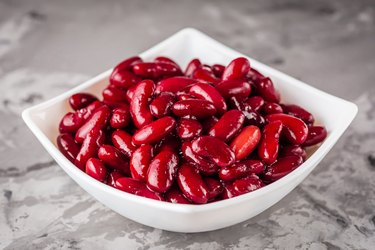
Understanding the difference between the cannellini and kidney beans can help you decide if a substitution is possible, depending largely on the recipe you're using and how the beans are prepared. The beans have some similarities that make them interchangeable in some dishes.
Cannellini Beans vs. Kidney Beans
Video of the Day
Cannellini beans are white Italian kidney beans, available in both dried and canned forms. Dried cannellini beans require soaking overnight before you cook them. Use the beans in salads, soups and stews or puree them for use in dips.
Video of the Day
They have about 225 calories per one-cup serving with 11 grams of fiber, 15 grams of protein and 40 grams of carbohydrates, per the United States Department of Agriculture (USDA). They also contain iron, magnesium and folate.
Kidney beans are a large dark red bean used in salads, chili, soups and stews. They're typically canned, although they're also available dried. They have about 215 calories per one-cup serving with 14 grams of fiber, 13 grams of protein and 37 grams of carbohydrates, per the USDA.
Substituting Kidney Beans for Cannellini Beans
While cannellini beans are a white kidney bean, they have a creamier texture than the darker red variety. In recipes specifically calling for white beans, the appearance of the dish is affected substantially if kidney beans are used.
Kidney beans may also affect the taste minimally if they're used whole in salads or soups instead of cannellini beans. Kidney beans won't work as well in recipes calling for pureed white beans because of the difference in creaminess and in color.
Tip
Substituting Great Northern or white navy beans for the cannellini beans offers a better result in both taste, appearance and creaminess than using kidney beans as the substitute.
Before soaking or cooking any dried bean, sort through them and remove any pebbles, debris or other residue.
Canned beans last as long as three years, while dried beans are good for up to one year. And cooked, dried beans stay good as long as three days when stored in the refrigerator.